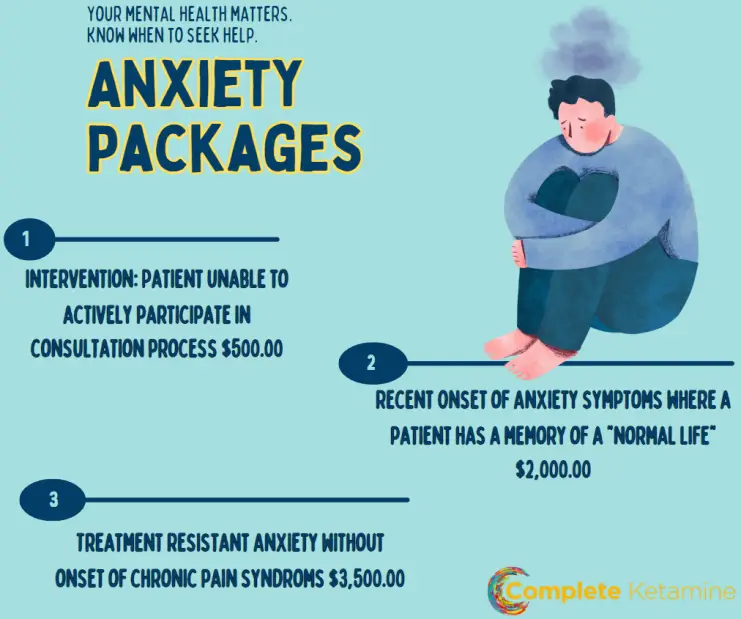How Does Ketamine Help Anxiety?
Understanding Anxiety & Traditional Treatments
Anxiety disorders are often characterized by hyperactivity in the brain’s fear and worry circuits, particularly in the amygdala and prefrontal cortex. Traditional anti-anxiety medications, such as benzodiazepines (e.g., Xanax, Valium), work by suppressing activity in these regions, but they do not promote long-term change in neural connections.
KBlend is a process that uses ketamine to help patients break free from the need to always be in control. Anxiety and panic attacks often stem from the desperate attempt to regain control when it feels like it is slipping away. By guiding patients to recognize that it is safe and healthy to be vulnerable and uncentered, KBlend helps retrain the brain to embrace discomfort rather than resist it. When this shift occurs, a panic attack becomes physically impossible, because panic is simply the body’s response to losing control.
KBlend is a process that uses ketamine to help patients break free from the need to always be in control. Anxiety and panic attacks often stem from the desperate attempt to regain control when it feels like it is slipping away. By guiding patients to recognize that it is safe and healthy to be vulnerable and uncentered, KBlend helps retrain the brain to embrace discomfort rather than resist it. When this shift occurs, a panic attack becomes physically impossible, because panic is simply the body’s response to losing control.
1. Ketamine Interrupts Fear-Based Thought Loops
Many people with anxiety disorders experience repetitive, intrusive thoughts that reinforce a state of chronic stress. Research has shown that ketamine blocks NMDA receptors, which play a key role in maintaining these rigid thought patterns. By disrupting these cycles, ketamine provides rapid relief from overwhelming anxious thoughts and allows patients to step outside of their conditioned fear responses.
2. Reducing Amygdala Overactivity
The amygdala, the brain’s fear center, is hyperactive in individuals with generalized anxiety, PTSD, and social anxiety disorder. Ketamine reduces amygdala hyperactivity, making it easier for patients to experience calmness and respond rationally to stressors. Unlike traditional anti-anxiety medications that simply 'mute' fear responses, ketamine actively restructures brain pathways to create long-term emotional stability.
3. Boosting Neuroplasticity for Long-Term Anxiety Relief
Anxiety can cause structural changes in the brain, particularly in the prefrontal cortex, which is responsible for rational thought and emotional regulation. Studies show that ketamine enhances neuroplasticity by increasing levels of brain-derived neurotrophic factor (BDNF), a protein that helps neurons form new, healthier connections.
KBlend works with this process by training patients to become comfortable with the sensation of letting go. When the brain learns that it is safe to not be in control, the physical symptoms of anxiety naturally subside. Instead of struggling against fear, patients experience a deep sense of surrender and emotional flexibility.
KBlend works with this process by training patients to become comfortable with the sensation of letting go. When the brain learns that it is safe to not be in control, the physical symptoms of anxiety naturally subside. Instead of struggling against fear, patients experience a deep sense of surrender and emotional flexibility.
4. Immediate Relief vs. Traditional Anxiety Treatments
Unlike SSRIs (e.g., Prozac, Zoloft), which take weeks to months to show benefits, ketamine can rapidly reduce anxiety symptoms within hours. This makes ketamine particularly useful for those with treatment-resistant anxiety or panic disorders, where traditional medications have failed.
Final Thoughts
Ketamine is not just another anti-anxiety medication; it is a tool that helps the brain relearn how to exist without fear. By interrupting fear-based thought loops, reducing amygdala hyperactivity, and promoting neuroplasticity, ketamine provides a powerful alternative to traditional medications. With the structured approach of KBlend, patients learn to embrace vulnerability and uncertainty, making panic attacks a thing of the past.
Buying Options:
- Category: Anxiety
- All pricing packages are subject to medical approval
- Refunds offered if a patient does not qualify for a discounted internet purchase
- Internet pricing only available online when paid in advance of consultation
- Internet pricing not available in-store or over the phone
For more details on ketamine treatment, pricing, and eligibility, visit our FAQ page.
What to Know Before Starting Ketamine Therapy
1. Schedule and Commitment
- ALL Treatments are performed in Monroe or Lansing Location.
- Most patients undergo two to three treatments per week over a two to three-week period.
- A typical initial treatment series consists of six infusions.
- Larger Packages may include more than 6 infusions.
- Intervention is one-time, one infusion, unless altered by provider
2. Transportation / Post-Treatment
- Patients must arrange for a driver to and from the clinic due to post-treatment effects.
- After each infusion, patients are monitored to ensure stability before discharge.
- Patients and Drivers will be given discharge instructions.
3. Pre-Treatment Preparations
- On the day of your session, avoid heavy meals to reduce nausea.
- Stay well-hydrated leading up to your appointment.
- Stop eating and drinking 4 hours prior to treatment.
- Do not come in dehydrated!
4. Medical Considerations
- Patients with high blood pressure should have their condition controlled before starting treatment.
- During treatment, vital signs (heart rate, blood pressure, oxygen levels) are closely monitored.
- Avoid Conflict and difficult situations before treatment.
5. Potential Side Effects
- Some patients may experience dissociation (a floating sensation or altered perception).
- Mild nausea can occur but can often be managed with proper dietary adjustments.
6. Patient & Caregiver Education
- Understanding the process and potential side effects helps ensure a successful treatment experience.
- Patients and caregivers should review all information before starting therapy.

